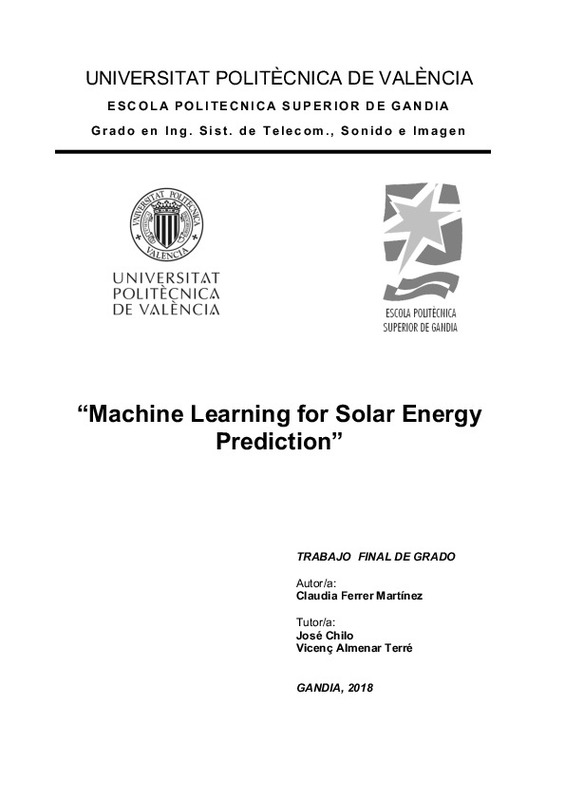|
Resumen:
|
[ES] El proyecto consistirá en el estudio de diferentes técnicas de Machine Learning aplicadas a la predicción de energía solar en plantas fotovoltaicas. Machine Learning puede mejorar el pronóstico de producción de energía ...[+]
[ES] El proyecto consistirá en el estudio de diferentes técnicas de Machine Learning aplicadas a la predicción de energía solar en plantas fotovoltaicas. Machine Learning puede mejorar el pronóstico de producción de energía solar en los sistemas fotovoltaicos haciendo uso de datos históricos del mismo sistema, y conseguir así una predicción más precisa.
Se revisará el proceso de implementar un modelo de Machine Learning paso a paso: recoger el dataset, procesarlo para poder utilizarlo como entrada para el modelo, dvívidir los datos en datos para entrenar el modelo, y datos para evaluarlo, entrenar y evaluar el algoritmo, y hacer los cambios necesarios para conseguir los mejores resultados.
El proyecto comenzará con una introducción teórica a Machine Learning. Se hará una revisión de los diferentes modelos o algoritmos, en concreto de aprendizaje supervisado, tal como Árboles de Decisión, Clasificación Naïve Bayer, Máquinas de Vector de Soporte (SVM), K-Vecino más cercano (KNN), Regresión Lineal, Regresión Logística, Redes Neuronales Artificiales (ANN).
A continuación, algunos de estos métodos serán implementados en MATLAB, con el fin de predecir energía solar partiendo de datos históricos de plantas fotovoltaicas. Los datos utilizados serán extraídos del Laboratorio Nacional de Energías Renovables ( National Renewable Energy Laboratory (NREL)), de EEUU, que provee un dataset llamado "Solar Power Data for Integration Studies", como dice en su página web oficial, destinado a desarrolladores de proyectos e investigadores universitarios que necesitan estimar la producción de energía para hipotéticas plantas solares. Este dataset consiste en datos de energía solar por hora durante un año, para aproximadamente 6000 plantas fotovoltaicas simuladas en EEUU.
Por último, una vez los diferentes modelos han sido implementados, se compararán y analizarán los resultados.
Hoy en día, muchos países utilizan energías producidas por fuentes renovables, como plantas solares, pero estos sistemas siguen teniendo algunas limitaciones. La predicción de producción de energía solar sería un gran avance para no sobre producit y malgastar energía, así como para cubrir la demanda de energía una manera optimizada. Además, el pronóstico de energía solar podría ayudar a la instalación de nuevas plantas fotovoltaicas en determinadas ubicaciones.
[-]
[EN] This thesis will consist of the study of different Machine Learning models used for solar power prediction in photovoltaic plants.
Machine Learning can improve the forecasting of solar power in each photovoltaic ...[+]
[EN] This thesis will consist of the study of different Machine Learning models used for solar power prediction in photovoltaic plants.
Machine Learning can improve the forecasting of solar power in each photovoltaic system since it would learn from its own historical data, and the prediction would be more accurate.
The process of implement a model of Machine Learning will be reviewed step by step: collect the data, processing of the data to be able to use it as input for the model, divide the data into training data and test data, training the Machine Learning algorithm with the training data, evaluate the algorithm with the testing data, and make the necessary changes to achieve the best results.
The thesis will start with an introduction to Machine Learning. Different models or algorithms of supervised learning will be reviewed, such as Decision Trees, Naïve Bayer Classification, Support Vector Machines (SVM), K-Nearest Neighbor (KNN), Linear Regression, Logistic Regression, Artificial Neural Network (ANN).
Then, some of these methods will be implemented using MATLAB in order to predict solar energy from historical data of photovoltaic plants. The data used to train and test the models will be extracted from the National Renewable Energy Laboratory (NREL), that provides a dataset called Solar Power Data for Integration Studies , as it says in its website, intended for use by Project developers and university researchers who need to estimate power production from hypothetical solar plants. The dataset consist of 1 year of hourly power data for approximately 6,000 simulated PV plants throughout the United States.
Finally, once the different models have been implemented, the results will be compared and discussed.
Nowadays, many countries use power provided by renewable sources, such as photovoltaic plants, but these systems still have some limitations. The prediction of solar power production would be a great improvement in order to not over produce and waste energy and meet the demand in an optimized way. In addition, the forecast of solar energy can help to set up new photovoltaic systems in determined locations.
[-]
|







